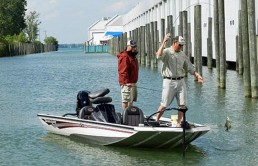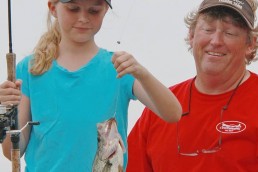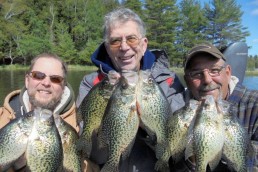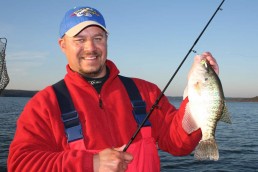Spring to Summer Sleuthing for Big-water Sunfish, Crappies and Perch
SHARE THIS POST
It’s one thing to find spring and summer panfish in a pond, creek, or small lake. But what do you do when your home water is one of the Great Lakes? Or a giant reservoir? Or a sprawling water body best known for bass, walleyes, trout, or other predators? Good news panfish fans. Even on big water, finding sunfish, crappies and even perch can be simpler than you think. And once you find them, these sweet species can be among the most palm-stretching specimens found anywhere.
In sprawling freshwater environs, sunfish and crappies tend to be homebodies, haunting relatively confined zones throughout the calendar year. No matter how big, deep or intimidating a water body, most contain prime shallow habitat used by panfish: boat harbors, marinas and other manmade backwater locales, plus natural bays, coves and creek inlets. Beginning in spring, nothing could be simpler than laying out a lake map and red X-ing vast portions of water in the main lake, particularly the stuff deeper than about 10 feet. Usually, what you’re left with is 5 percent of the lake’s area—the good stuff near shore that always holds panfish.
Searching for sunfish
Best known for his success in bigwater bass tournaments, Joe Balog is also a confirmed panfish sneak, hunting shallow habitats from ice-out in March all the way through summer. A resident of Michigan’s Lake St. Clair—which lies between lakes Erie and Huron and encompasses 430 square miles—Balog loves chasing springtime pumpkinseeds. An intriguing, exotically beautiful member of the sunfish clan, ‘seeds, says Balog, are a bigtime mussel eater that spawn on hard bottom, often near mussel beds.
“Pumpkinseeds possess unique grinders in their throat that give them the ability to dine effortlessly on zebra mussels, crayfish and other invertebrates,” he says. “What’s neat is that on a lake like St. Clair, you’ve got real confined shallow bays that possess both hard-bottom and pondweed (cabbage). So I can take a giant lake and quickly narrow it down to just a few dozen acres—spots easily discerned on a LakeMaster digital map. The fish will often linger in these zones, spring through summer.
“Some of my favorite spring fishing occurs on warm, mostly calm days when you can get out and sunglass the water while cruising around with the Minn Kota. Because the fish often bunch into little areas like a 6-foot by 6-foot patch of cabbage, it’s real easy to miss ‘em. So it’s probably some of the most weather-dependent fishing I do all year. Certainly, you can get out on cloudy or windy days, and search. But then, it’s a matter of using my Humminbird side imaging to canvas these flats and look for both weed patches and small pods of panfish on screen. Once they begin spawning, I can even spot the beds right on my Onix unit, which is a huge advantage.”
On his favorite warm spring days, Balog relishes pitching small 1/32-ounce tube jigs and Beetle Spins into pockets in the vegetation, or along subtle transitions, such as a three- to five-foot break where mussels and crayfish often cluster together between the weeds and hard bottom, right on that little edge. The Beetle Spin, Balog says, shines as a search tool.
Once fish reveal themselves, working them over with tiny plastics, such as a Custom Jigs & Spins Finesse Plastic or Wedgee—either on a light jig or beneath a slip float—yields fast action. Balog wields an ultralight, 6-foot Daiwa Presso rod with 4-pound-test mono for most of his ‘seed fishing. Likewise, St. Croix’s Panfish Series rods have also proven themselves as “new classic” sunfish sticks.
Marina crappies
Are you enjoying this post?
You can be among the first to get the latest info on where to go, what to use and how to use it!
On some of these same days—when water temps linger in the low- to mid-60s—Balog’s boat often slips inside one of St. Clair or Erie’s man-made harbors. Here, the usual suspects are big black and white crappies, as well as sunfish and the occasional ponderous perch. Crappies, however, provide the most consistent fishing.
“Crappies live in some of these deepwater marinas all year long,” Balog notes, “as well as in many of the channels and canals on St. Clair’s north end.
“In the marinas, it’s funny how crappies can be real picky about which stretch of docks of pilings they relate to, or even spawn on. A great method for locating the exact position of the fish is to use an Aqua-Vu Micro Camera. I like to mount the camera on a telescopic painter’s pole (10 to 15 feet long), and periscope under docks, large boats and around concrete or metal pilings. Crappies often cling super tight to specific objects, and often won’t budge more than a foot or two to grab a lure. Once I identify the types of cover the fish are using and how they’re positioned on it, I can usually catch them with tubes, slip bobbers, or little hair jigs.”
Wolfpacks of perch
While sunfish and crappies are comfortable hanging around relatively small home ranges, yellow perch often range much further, season to season. Balog finds small pods of big perch, some upwards of 14 inches, roving through shallow bulrushes and pencil reeds, rooted on hard bottom flats. The move usually occurs in postspawn—from late May into June—on many inland lakes, including St. Clair. A similar pattern also occurs in late summer into early fall, when perch return to shallow bulrush flats.
Bass anglers frequently collide with big perch while throwing spinnerbaits, as well as plastic worms.
“These fish are super aggressive,” says Balog. “Finding them is the biggest obstacle, but by fishing fast with Beetle Spins, small plastics or even cranks, the fish actually tend to find you pretty quick. Once or so each spring, you get one of those days when the system clicks on all cylinders, and you connect with beautiful pound-plus panfish of all three species. Big water. Big fish. A ton of fun.”
MWO
SHARE THIS POST
Did you enjoy this post?
You can be among the first to get the latest info on where to go, what to use and how to use it!
Ted Pilgrim
MidWest Outdoors works with more than 200 outdoor experts each year, who contribute articles based on their areas of expertise. MidWest Outdoors magazine offers more fishing and hunting articles than any other publication!



